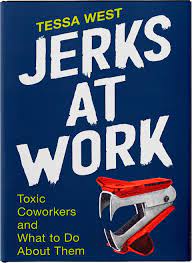The one-sentence summary
There are always jerks at work but you can deal with them effectively by recognising their archetypes, understanding how they tick, and using tactics to expose their weak points and restore your emotional wellbeing.
Can’t be bothered to read it? Too much screen time lately? Listen to the 5-minute podcast in two parts.
- This is a practical and often amusing book by a New York University Professor of Psychology. She identifies seven types of toxic co-worker:
-
- Kiss up/kick downer: belittles you in front of those they want to impress
- The Credit Stealer: opportunistically takes credit for the work of others
- The Bulldozer: asserts power early on, finds teams that can’t function without their expertise, bullies bosses into submission
- The Free Rider: works on teams where it’s hard to establish who did what, takes on work that has the veneer of importance but requires little effort
- The Micromanager: always provides unreasonable deadlines, assigns mind-numbing useless tasks, then disappears completely for long periods
- The Neglectful Boss: ignores you for long periods, then sweeps in to exert control, usually at an inappropriate stage of a project
- The Gaslighter: isolates you by making you feel part of something special, destroys your sense of self-worth, starts with small lies then moves on to big ones
WHAT’S GOOD ABOUT IT
- Social comparison orientation is the degree to which we compare ourselves with other people.
- Status acuity helps Kiss up/kick downers to assess rapidly who to compare themselves with and who they can safely criticise to those in power. Social dominance orientation means that they enjoy competitive hierarchies.
- Those who have the biggest voice at work tend to be those known as an advice tie – someone others go to for advice on how to get ahead.
- The spotlight effect is a common bias that makes people overestimate how much other people are paying attention to them.
- In the Ringelmann Effect, commonly known as social loafing, people decrease the amount of effort they put into a job the more people are on the team. (Ringelmann was a Professor of Agricultural Engineering and noticed this in teams of oxen pulling loads).
- If you have one or more of the Three C’s in your team, you may be exposed to free riding – that’s conscientiousness, cohesion and collective rewarding.
- Contrafreeloading is where employees put in extra effort because they actually enjoy the process of their job, not for external rewards like money.
- Micromanagers are the most common jerks at work. 79% of people have been micromanaged in their careers, and 69% have considered quitting because of it.
- The faith in supervision effect makes micromanagers believe that more monitoring equals better performance. There is no evidence for this.
- 89% of bosses think people quit because they want more money, but only 12% quit for this reason – it’s because they don’t like how they’re managed.
- Failure to communicate expectations early on in a job is the number one complaint people have about their bosses.
- According to John Gottman, the Four Horsemen of unhealthy conflict conversations are criticism, contempt, defensiveness and stonewalling. This sequence usually happens when jerks are confronted about their behaviour.
- Transparency bias is when bosses assume that the people that work for them know all kinds of things that they don’t.
- The end-stage micromanager focuses on micro-indicators to suggest that the work isn’t ready – they hide behind perfectionism to stop or delay launches.
- 76% of new managers have been given no training at all in their new role.
- Toxic positivity prevents relentlessly positive people from seeing flaws in others, leaving them unprepared to cope with jerks.
WHAT YOU HAVE TO WATCH
- Very little. The book provides readily-identifiable typologies backed up by proper research, and any employee recognising the characteristics can take the related advice to improve their situation.

